- Home
- John Irving
My Movie Business: A Memoir Page 5
My Movie Business: A Memoir Read online
Page 5
Phillip died; Lasse got to make the picture his way, not Phillip’s.
Suffice it to say that of the four directors who tried to envision the story, Phillip arrived at the grimmest vision.
Because I loved Phillip, and was halfway persuaded by him, I felt that Homer without a love life was a deeper and darker character than Homer in love. The Cider House Rules was not a love story, Phillip Borsos and I decided. It was a history of illegal abortion. The black migrants, Rose Rose and her father, are just other orphans. In a world where that necessary procedure was illegal and unsafe, the world was an orphanage. (Hence the cider house, where Homer lives with the apple pickers after he leaves St. Cloud’s, and the orphanage of Homer’s childhood and young manhood are depressingly similar.)
But in not allowing Homer to have his love story, Phillip and I presented a screenplay for production that was probably too depressing to ever have been made; at least we couldn’t get it made, although we came close. We held a
6190_Irving_10_js.qxd 8/23/99 5:40 PM Page 55
M Y
M O V I E
B U S I N E S S
5 5
reading of the script in Paul Newman’s living room—Paul was Phillip’s first choice to play Dr. Larch, the role ultimately played by Michael Caine—but Paul wasn’t con-
vinced.
“There are so many scenes at that incinerator,” he said to me, shaking his head. “That incinerator really gets to me.”
When Paul turned down the part of Dr. Larch, Phillip and I were discouraged. Without a Larch of Paul Newman’s stature, what kind of production money could we attract? The wrong kind, as it turned out. In the world of would-be producers, you can meet some truly vile people, and Phillip and I had the misfortune to meet them.
If serious illness, even cancer, can be caused by stress (as some people maintain), then these particular would-be producers are responsible for Phillip’s death. I hold them responsible, anyway. They nearly succeeded in
ruining the prospect of The Cider House Rules ever being a movie. Nor are they worth mentioning by name or
by company; in the landscape of Hollywood, they’re as familiar as litter. I think of them as the foam-plastic cof-fee cups strewn around a construction site, the debris the workers leave behind.
Later, when Phillip got too sick to direct the picture, we tried to find a director to replace him. Ironically, our first choice was Lasse Hallström, the Swedish director who eventually would direct the film—both Phillip and I had
6190_Irving_10_js.qxd 8/23/99 5:40 PM Page 56
5 6
J O H N I R V I N G
loved Hallström’s My Life as a Dog—but Lasse wasn’t available at the time.
When Phillip died, I thought it was unlikely that the movie of The Cider House Rules would ever be made. For a while, I didn’t think it should be made—not without Phillip.All that hardly matters now, because the movie that was made wasn’t the bleak version.
6190_Irving_11_js.qxd 8/23/99 5:41 PM Page 57
1 1
N O E S C A R G O T
had tried to write a screenplay only once before I began the script of The Cider House Rules. Irvin Kershner Iwanted to direct a film of SettingFreetheBears, my first novel. Kershner had directed The Luck of Ginger Coffey, from the Brian Moore novel, and he was (at the time) trying to make a movie of Moore’s The Lonely Passion of Judith Hearne. I had greatly admired the film of Ginger Coffey, and Kershner and I shared a fondness for everything by Brian Moore. In 1969, Columbia Pictures optioned the movie rights to Setting Free the Bears and hired me to write the screenplay for Kershner.
I left for Austria in August of that year, buying a red Volvo in Paris en route. The hardcover sales of Setting Free the Bears were well below bestseller levels (fewer than ten
6190_Irving_11_js.qxd 8/23/99 5:41 PM Page 58
5 8
J O H N I R V I N G
thousand copies), but they were better than I’d expected for a first novel; there’d also been a paperback sale, in addition to the movie option.A Volvo wasn’t exactly a luxury car in those days, but it was my first luxury car—meaning it was the first car I could actually afford. To drive a brand-new car in Paris, and through France and Switzerland into Austria . . . well, it’s something everyone should do once.
Until that summer, the only other time I’d been in Paris, I’d been in a bus.
I had not been back to Vienna since I’d been a student there, at the Institute of European Studies and the University of Vienna, in 1963 and ’64. Now, a former professor of mine, Ernst Winter, rented me a wing of his castle in the village of Eichbüchl on the outskirts of Wiener
Neustadt—over which my father’s squadron had flown,
dropping bombs, more than twenty years before. (My
father, a Slavic languages and literature major at Harvard, had been a cryptographer for the U.S. Army Air Corps during World War II.)
Schloss Eichbüchl was a real castle, originally built by Charlemagne. Nazi officers had lived there. Some of them had been machine-gunned on the stairs leading to the dun-geon; you could see the pockmarks the bullets had left in the walls. But in 1969, when I lived at the castle, the dun-geon was a potato cellar.
The Winter family had uncountable children, most of
6190_Irving_11_js.qxd 8/23/99 5:41 PM Page 59
M Y
M O V I E
B U S I N E S S
5 9
whom were teenagers and all of whom were impressive; Kershner and I grew very fond of them while we were
writing and rewriting the screenplay for Setting Free the Bears in the castle library.
My eldest son, Colin, was four and a half when his
brother Brendan was born in Vienna that September.
Colin had the run of the castle, which he loved, and the Winter children took turns babysitting for Brendan.
When Kershner and I weren’t shouting at each other in the library—Kershner, like me, is a shouter—we were in the war archives in Vienna, watching about forty-eight hours of newsreel footage, most of which detailed Hitler’s triumphant arrival in the Austrian capital in 1938. There the Führer was, waving from his Mercedes and addressing the multitude in the Heldenplatz (the Plaza of Heroes).
Later Hitler spoke to the crowd from a balcony of the Hof-burg palace.
There was also some remarkable footage of Göring in
Lederhosen. He is kissing children at a picnic somewhere near Salzburg. He goes from picnic table to picnic table, grinning ear to ear, kissing the children at every table.
The future field marshal was positively charming, and he had such a way with kids that Kershner and I at first failed to recognize him. We kept asking the projectionist, an old man with a patch over one eye, to rewind the film and show us the footage again. The hearty young man
6190_Irving_11_js.qxd 8/23/99 5:41 PM Page 60
6 0
J O H N I R V I N G
kissing the children was very familiar, but we couldn’t quite place him.
Finally, in exasperation, Kershner turned to the projectionist. “Who is that guy?”
“Das ist Hermann Wilhelm Göring,” the old man said with great dignity; his one eye, which he turned away from us, was brimming with tears.
While Kershner and I made quick use of the newsreel
footage of the Anschluss, we could never find a place in the screenplay of Setting Free the Bears for Göring to kiss the children at the picnic, although we tried. (I liked the idea of using it during the opening credits.)
It was great fun working with Kershner. He was a wild man with a nonstop imagination and boundless energy. He was also the most passionate reader I ever knew; the man read everything. Kershner was such an enthusiast for the story of Setting Free the Bears that he contributed more to the screenplay than I was able to bring to it. He never tired of retelling the story, always in a slightly different way. I just tried to keep up with him, which wasn
’t easy.
Kershner never sat down. He paced. He would recite
the entire story, from the opening shot to the end credits, without once referring to the existent script. I would struggle to write everything down. I felt more like a stenographer than a screenwriter. Kershner was the real screenwriter—I was just taking dictation.
6190_Irving_11_js.qxd 8/23/99 5:41 PM Page 61
M Y
M O V I E
B U S I N E S S
6 1
“You changed something! Stop!” I would shout. “You
just changed something!”
“Of course I changed something!” he would shout back, never stopping or even slowing down. “I’m always chang-ing something! It’s my job to change something!”
Then he would fly back to New York or Los Angeles,
leaving me to compose a new script from his notes. It was terribly exciting, but the checks from Columbia Pictures were always late. And there is something about the movie business that is even worse than not being paid—it is the presumption on the part of the people putting up the money that they have an unassailable right to interfere with what happens in the screenplay and with the outcome of the film. (Please don’t forget that people put up money to publish books, too. Publishers, among them even the toughest editors, ask writers to make changes; they don’t tell you that you have to make the changes, or simply make them for you.)
Nevertheless, Kershner was my hero, championing
each draft of the screenplay, returning to the castle library to shout a new draft into existence.
One spring day we were walking in a pear orchard near Schloss Eichbüchl when Kershner paused in midscript to stare at the ground. He had discovered snails.
“Escargot!” he cried.
In Austria they called them Schnecken, but they were es-
6190_Irving_11_js.qxd 8/23/99 5:41 PM Page 62
6 2
J O H N I R V I N G
cargot to Kershner.We found an empty crate, probably for the pears, and we filled it with the snails. There was a cookbook in the castle that explained how to “purify” snails before cooking them. You put clean lettuce in the crate with them; when they eat the lettuce, they are purified.
Somehow.
Frau Winter said that she had purified snails many
times, following the instructions in this book. Naturally you had to be sure that the snails were of the edible kind in the first place. Frau Winter assured us that our snails were.
Kershner was very excited to be having escargot. He
wanted to bake fresh bread. Did we have enough garlic? he asked.
In the morning, all the snails were dead. Maybe the lettuce had killed them. Maybe they weren’t the edible kind, after all, Frau Winter confided to us.
Frau Winter had been one of the Trapp Family
Singers—one of the children. She could (and did) tell you some stories. Kershner and I adored her. But Kershner was crestfallen over the death of the snails.
“No escargot,” he said. This, together with the late checks, was the earliest sign that the movie of Setting Free the Bears was in trouble.
Orson Welles was going to be in it, playing the grandfather. Then Vittorio De Sica was going to be the grandfather. Helmut Berger was going to be Siegfried Javotnik,
6190_Irving_11_js.qxd 8/23/99 5:41 PM Page 63
M Y
M O V I E
B U S I N E S S
6 3
the doomed hero. Jon Voight was going to be Hannes
Graff, the sidekick. Then Al Pacino was going to be Graff.
That was how the guys at Columbia Pictures talked (effu-sively), but their checks came later and later—and, finally, not at all.
I left Vienna for London in May 1970 with my wife and two children, flying home to the United States from London. I’d shipped the Volvo home from France before sailing to England. It arrived in New York weeks later, crusted with salt, the paint faded like that on a forty-year-old car.
My Volvo must have crossed the Atlantic on an open deck, or else it was towed behind the ship, making the voyage underwater.
At least the car got there. The same cannot be said for the first couple of chapters of my second novel, The Water-
Method Man, then in progress. I had shipped the chapters in a steamer trunk, together with some winter clothes, from Vienna to Vermont. The trunk never arrived. I didn’t miss the clothes; I rewrote the chapters, probably improv-ing them in the process. From my first experience of writing a screenplay, I had learned something about the process of revision.You can always make something better, and if you make it worse, you’ll know it. I had learned to have no fear of rewriting. All writers should be so lucky.
Like most potential movies, Setting Free the Bears was never made. But Irvin Kershner has survived unbowed. He
6190_Irving_11_js.qxd 8/23/99 5:41 PM Page 64
6 4
J O H N I R V I N G
is still my hero. I had breakfast with him in Santa Monica about a year and a half ago. We did a lot of wonderful shouting. Kershner hasn’t changed in thirty years. Not even directing The Empire Strikes Back has aged him—the miraculous “force” is still with him. He was going to direct a film about Puccini, he said. (Actually the main character is a young girl who studies with Puccini, I think.) Once again, Kershner described the story at such a breathtaking pace that I struggled to keep up. Kershner is a passionate enthusiast whose energy is somehow unsullied by the
movie business, even though he’s in it.
In Santa Monica, the morning sun was beating down
on his magnificent bald head. He asked a waiter to move an umbrella in order to shade him from the sun. It was a polite and reasonable request, but Kershner is a movie director in everything he says. There is something commanding even about his politeness. The waiter frantically sought to please him. Soon another waiter and a waitress joined our waiter in the effort to keep Kershner’s head in the shade. If it had been cloudy and Kershner had asked for more sun, all of us would have tried to open the heav-ens for him.
Naturally Kershner and I remembered aloud the con-
siderable energy we had expended on behalf of Setting Free the Bears at Schloss Eichbüchl. We also talked about Frau Winter, the former Trapp singer, who is dead now, and her
6190_Irving_11_js.qxd 8/23/99 5:41 PM Page 65
M Y
M O V I E
B U S I N E S S
6 5
wonderful children, who once looked after Brendan.
Kershner was shocked at the news of Frau Winter’s death; to him, she seemed indestructible. On his face was the genuine outrage and sorrow that I saw there when the snails died, and when Columbia Pictures pulled the plug on Setting Free the Bears.
6190_Irving_12_js.qxd 8/23/99 5:42 PM Page 66
1 2
F I R S T H A I R C U T
The next movie director to enter my life was George
Roy Hill, who directed The World According to Garp.
There was never any danger of the plug being pulled
on George. He was an ex-Marine; he took charge of everyone. The success of Butch Cassidy and the Sundance Kid and The Sting had made the team performances of Paul Newman and Robert Redford renowned, and George had been their general. He commanded a loyal following of people who’d worked with him before—among them Bobby
Crawford, his producer, and Marion Dougherty, his old friend and casting director.
On one of the Garp locations, in Millbrook, New York—the site of the so-called Steering Academy—two
distinguished guests visited the set, Paul Newman one day, James Cagney another. At the time I wondered why such
6190_Irving_12_js.qxd 8/23/99 5:42 PM Page 67
M Y
M O V I E
B U S I N E S S
6 7
veteran actors would come to a movie set in the summer heat to watch a small, unmemorable scene be
shot over and over again—for two or three hours. Later I understood why. They were not only paying their respects to George; they wanted to watch the general with his troops.
Even in the smallest scene, to see George in control was inspiring. He was the epitome of the commanding officer you would willingly die for; he conveyed the kind of courage that convinced you he would unhesitatingly die for you, too. Handsome, courtly, and with a bad back—
from crashing a plane, I was told—George was also a
pilot. He was one of those men you put your trust in absolutely.
Yet when George asked me to write the screenplay for Garp, I declined. I was writing my fifth novel, The Hotel New Hampshire, at the time; I knew very little about the movie business, but I knew enough not to stop a novel to start a screenplay.
“I’ll ask you only once,” George told me. He was true to his word. Steve Tesich wrote the script for Garp.
When George showed me Steve’s first draft, I didn’t
like it. Now it’s easy to see that I have been much more extreme in translating two of my novels into screenplays—
The Cider House Rules and A Son of the Circus—than Steve Tesich was with Garp. But at the time I believed that the best adaptation from a novel to a film was a literal one.
We are always more permissive of our own extremism
6190_Irving_12_js.qxd 8/23/99 5:42 PM Page 68
6 8
J O H N I R V I N G
than we are of someone else’s. Steve changed Vienna to New York—that took some getting used to.And there is an airplane that crashes into Garp’s house just before he buys the house, thus (in Garp’s mind) making the house safe from other disasters. (Naturally, he’s wrong.) There is no airplane in the novel. In the film, George Roy Hill himself plays the pilot who walks away from the crash, unharmed.
In the end, as Garp is dying, a helicopter carries him away.
“What helicopter?” I asked George.
But these details are more Garp-like than I first thought; in the movie, they work. A more enduring problem is the difference between Steve Tesich’s sense of humor and mine. Steve was a guy who told jokes—good ones, but

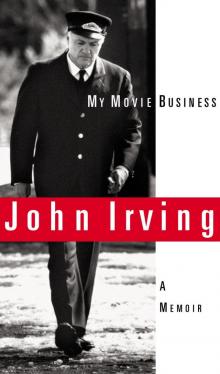 My Movie Business: A Memoir
My Movie Business: A Memoir In One Person
In One Person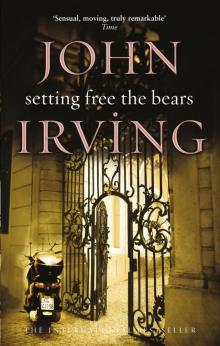 Setting Free the Bears
Setting Free the Bears The Fourth Hand
The Fourth Hand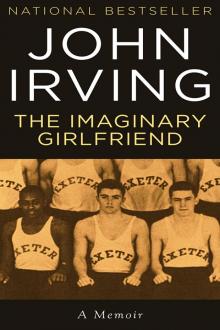 The Imaginary Girlfriend
The Imaginary Girlfriend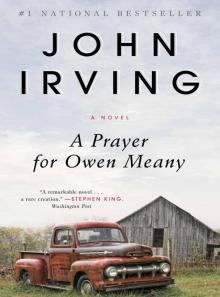 A Prayer for Owen Meany
A Prayer for Owen Meany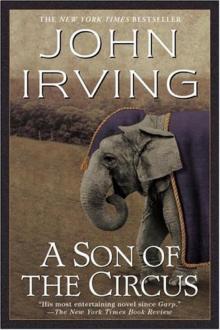 A Son of the Circus
A Son of the Circus Last Night in Twisted River
Last Night in Twisted River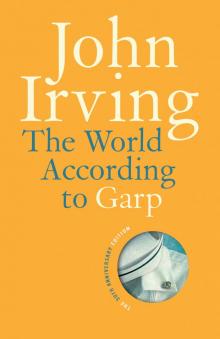 The World According to Garp
The World According to Garp The Cider House Rules
The Cider House Rules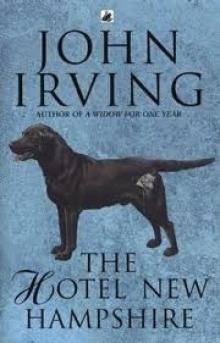 The Hotel New Hampshire
The Hotel New Hampshire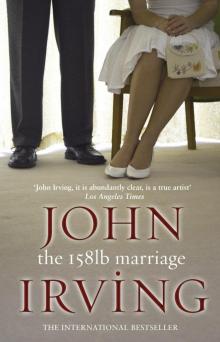 The 158-Pound Marriage
The 158-Pound Marriage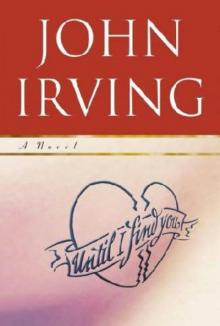 Until I Find You
Until I Find You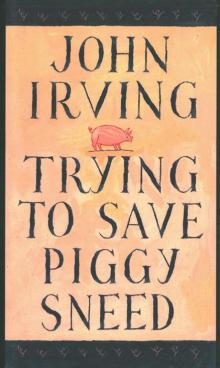 Trying to Save Piggy Sneed
Trying to Save Piggy Sneed Cider House Rules
Cider House Rules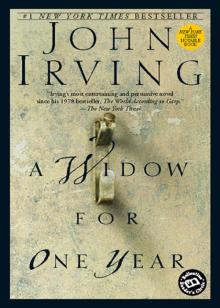 A Widow for One Year
A Widow for One Year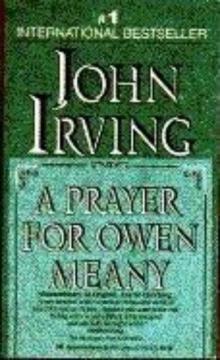 A prayer for Owen Meany: a novel
A prayer for Owen Meany: a novel (2005) Until I Find You
(2005) Until I Find You